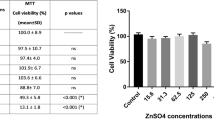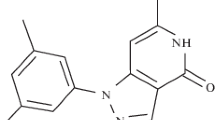Abstract
Prostate cancer is the most predominant cancer in men and related death rate increases every year. Till date, there is no effective therapy for androgen independent prostate cancer. Previous studies reported that aged garlic extract suppresses cancer growth. In the present study, diallyl disulfide [DADS], oil soluble organosulfur compound of garlic, was studied for its antiproliferative and induction of cell cycle arrest on prostate cancer cells in vitro. The suppression of cell growth was assessed by MTT assay. Induction of cell cycle arrest was assessed and confirmed by propidium iodide staining in flowcytometric analysis and western blotting analysis of major cell cycle regulator proteins. The results showed that DADS inhibited the growth of prostate cancer cells in a dose dependent manner, compared to the control. At 25 μM and 40 μM concentrations, DADS induced cell cycle arrest at G2/M transition in PC-3 cells. Western blotting analysis of cyclin A, B1 and cyclin dependent kinase 1 [CDK1] revealed that DADS inhibited the cell cycle by downregulating CDK1 expression. It is concluded that DADS, inhibits proliferation of prostate cancer cells through cell cycle arrest. Dose dependent effect of DADS on PC-3 cell line was observed in the present study.
Similar content being viewed by others
References
Jemal A, Thomas A, Murray T, Thun M: Cancer statistics, 2002. CA Cancer J Clin 52: 23–47, 2002
Kish JA, Bukkapatnam R, Palazzo F: The treatment challenge of hormone-refractory prostate cancer. Cancer Control 8: 487–495, 2001
Brawley OW, Barnes S, Parnes H: The future of prostate cancer prevention. Ann NY Acad Sci 952: 145–152, 2001
Breslow N, Chan C, Dhom G, Drury R, Franks L, Gellei B, Lee Y, Lundberg S, Sparke B, Sternby N, Tulinius H: Latent carcinoma of the prostate at autopsy in seven areas. Int J Cancer 20: 680–688, 1977
Flanders W: Prostate cancer epidemiology. Prostate 5: 621–629, 1984
Haenszel W, Kurihara M: Studies of Japanese migrants. I. Mortality from cancer and other diseases among Japanese in the United States. J Natl Cancer Inst 40: 43–68, 1968
Severson R, Nomura A, Grove J, Stemmermann G: A prospective study of demographics, diet, and prostate cancer among men of Japanese ancestry in Hawaii. Cancer Res 49: 1857–1860, 1989
Adlercreutz H: Western diet and Western diseases: some hormonal and biochemical mechanisms and associations. Scand J Clin Lab Invest 50 (Suppl.): 3–23, 1990
Hsing AW, Chokkalingam AP, Gao YT, Madigan MP, Deng J, Gridley G, Fraumeni Jr JF: Allium vegetables and risk of prostate cancer: a population-based study, J Natl Cancer Inst 94: 1648–1651, 2002
Milner JA: Mechanisms by which garlic and allyl sulfur compounds suppress carcinogen bioactivation. Garlic and carcinogenesis. Adv Exp Med Biol 492: 69–81, 2001
Siegel G, Malmsten M, Pietzsch J, Schmidt A, Buddecke E, Michel F, Ploch M, Schneider W: The effect of garlic on arteriosclerotic nanoplaque formation and size. Int J Phytotherapy Phytopharmacol 11: 24–35, 2004
Tsao S, Yin M: In vitro activity of garlic oil and four diallyl sulphides against antibiotic-resistant Pseudomonas aeruginosa and Klebsiella pneumoniae. J Antimicrobial Chemotherapy 47: 665–670, 2001
Kwon MJ, Song YS, Choi MS, Park SJ, Jeong KS, Song YO: Cholesteryl ester transfer protein activity and atherogenic parameters in rabbits supplemented with cholesterol and garlic powder. Life Sci 72: 2953–2964, 2003
Hong YS, Ham YA, Choi JH, Kim J: Effects of allyl sulfur compounds and garlic extract on the expression of Bcl-2. Bax, and p53 in non small cell lung cancer cell lines. Exp Mol Med 32: 127–134, 2000
Nakagawa H, Tsuta K, Kiuchi K, Senzaki H, Tanaka K, Hioki A, Tsubura A: Growth inhibitory effects of diallyl disulfide on human breast cancer cell lines. Carcinogenesis 22: 891–897, 2001
Takezaki T, Gao CM, Wu JZ, Ding JH, Liu YT, Zhang Y, Li SP, Su P, Liu TK, Tajima K: Dietary protective and risk factors for esophageal and stomach cancers in a low-epidemic area for stomach cancer in Jiangsu Province. China: comparison with those in a high-epidemic area. Jap J Cancer Res 92: 1157–1165, 2001
Iimuro M, Shibata H, Kawamori T, Matsumoto T, Arakawa T, Sugimura T, Wakabayashi K: Suppressive effects of garlic extract on Helicobacter pylori-induced gastritis in Mongolian gerbils. Cancer Lett 187: 61–68, 2002
Ku DD, Abdel-Razek TT, Dai J, Kim-Park S, Fallon MB, Abrams GA: Garlic and its active metabolite allicin produce endothelium- and nitric oxide-dependent relaxation in rat pulmonary arteries. Clin Exp Pharmacol Physiol 29: 84–91, 2002
Guyonnet D, Belloir C, Suschetet M, Siess MH, Le Bon AM: Liver subcellular fractions from rats treated by organosulfur compounds from Allium modulate mutagen activation. Mutat Res 466: 17–26, 2000
Le Bon AM, Roy C, Dupont C, Suschetet M: In vivo antigenotoxic effects of dietary allyl sulfides in the rat. Cancer Lett 114: 131–134, 1997
Sheen LY, Wu CC, Lii CK, Tsai SJ: Effect of diallyl sulfide and diallyl disulfide, the active principles of garlic, on the aflatoxin B-1-induced DNA damage in primary rat hepatocytes. Toxicol. Lett 122: 45–52, 2001
Guyonnet D, Belloir C, Suschetet M, Siess MH, Le Bon AM: Antimutagenic activity of organosulfur compounds from Allium is associated with phase II enzyme induction. Mutat Res 495: 135–145, 2001
Siess MH, Le Bon AM, Canivenc-Lavier MC, Suschetet M: Modification of hepatic drug-metabolizing enzymes in rats treated with alkyl sulfides. Cancer Lett 120: 195–201, 1997
Hu X, Singh SV: Glutathione S-transferases of female A/J mouse lung and their induction by anticarcinogenic organosulfides from garlic. Arch Biochem Biophys 340: 279–286, 1997
Guyonnet D, Siess MH, Le Bon AM, Suschetet M: Modulation of phase II enzymes by organosulfur compounds from allium vegetables in rat tissues. Toxicol Appl Pharmacol 154: 50–58, 1999
Knowles LM, Milner JA: Allyl sulfides modify cell growth. Drug Metabol Drug Interact 17: 81–107, 2000
Sundaram SG, Milner JA: Diallyl disulfide suppresses the growth of human colon tumor cell xenografts in athymic nude mice. J Nutr 126: 1355–1361, 1996
Arunkumar A, Vijayababu MR, Kanagaraj P, Balasubramanian K, Aruldhas MM, Arunakaran J: Growth suppressing effect of garlic compound diallyl disulfide on prostate cancer cell line (PC-3) in vitro. Biol Pharm Bull 28: 740–743, 2005
Gunadharini DN, Arunkumar A, Krishnamoorthy G, Muthuvel R, Vijayababu MR, Kanagaraj P, Srinivasan N, Aruldhas MM, Arunakaran J: Antiproliferative effect of diallyl disulfide (DADS)on prostatic cancer cell line (LNCaP). Cell Biochem Func 23: 1–6, 2005
Yuan JP, Ling H, Zhang MX, Liu Y, Song Y, Su Q: Diallyl disulfide-induced G2/M arrest of human gastric cancer MGC803 cells involves activation of p38 MAP kinase pathways, Ai Zheng 23: 169–172, 2004
Rasola A, Geuna M: A flowcytometry assay simultaneously detects independent apoptotic parameters. Cytometry 45: 151–157, 2001
Lawson LD, Wang ZJ: Pre-hepatic fate of the organosulfur compounds derived from garlic [Allium sativum]. Planta Med 59: A688–689, 1993
Dausch JG, Nixon DW: Garlic: A review of its relationship to malignant disease. Prev Med 19: 346–61, 1990
Druesne N, Pagniez A, Mayeur C, Thomas M, Cherbuy C, Duee PH, Martel P, Chaumontet C: Diallyl disulfide (DADS)increases histone acetylation and p21(waf1/cip1) expression in human colon tumor cell lines. Carcinogenesis 25: 1227–1236, 2004
Yuan JP, Ling H, Zhang MX, Liu Y, Song Y, Su Q: Diallyl disulfide induced G2/M arrest of human gastric cancer MGC803 cells involves activation of p38 MAP kinase pathways, Ai Zheng 23: 169–172, 2004
Knowles LM, Milner JA: Depressed p34cdc2 kinase activity and G2/M phase arrest induced by diallyl disulfide in HCT-15 cells, Nutr Cancer 30: 169–174, 1998
Wu CC, Chung JG, Tsai SJ, Yang JH, Sheen LY: Differential effects of allyl sulfides from garlic essential oil on cell cycle regulation in human liver tumor cells. Food Chemical Toxicol 42: 1937–1947, 2004
King RW, Jackson PK, Kirschner MW: Mitosis in transition. Cell 79: 563–571, 1994
Coleman TR, Dunphy WG: Cdc2 regulatory factors. Curr Opin Cell Biol 6: 877–882, 1994
Obaya AJ, Sedivy JM: Regulation of cyclin-Cdk activity in mammalian cells. Cell Mol Life Sci 59: 126–142, 2002
Bulavin DV, Higashimoto Y, Popoff I, Gaarde W, Basrur V, Potapova O, Appella E, Fornace A: Initiation of a G2/M checkpoint after ultraviolet radiation require p38 kinase. Nature 411: 102–106, 2001
Peng CY, Graves PR, Thoma RS, Wu Z, Shaw AS, Piwnica- Worms H. Mitotic and G2 checkpoint control: Regulation of 14-3-3-protein binding by phosphorylation of cdc25C on serine- 216. Science 277: 1501–1505, 1997
Author information
Authors and Affiliations
Corresponding author
Rights and permissions
About this article
Cite this article
Arunkumar, A., Vijayababu, M.R., Srinivasan, N. et al. Garlic Compound, Diallyl Disulfide Induces Cell Cycle Arrest in Prostate Cancer Cell Line PC-3. Mol Cell Biochem 288, 107–113 (2006). https://doi.org/10.1007/s11010-006-9126-6
Received:
Accepted:
Published:
Issue Date:
DOI: https://doi.org/10.1007/s11010-006-9126-6




